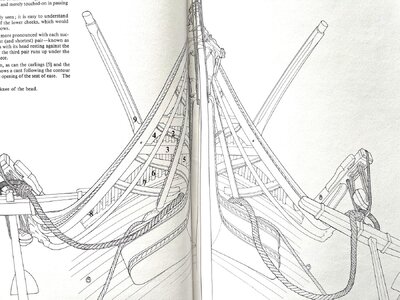My personal "guestimation" on that matter is that the complete structure of that Bow´s Head serves mainly as a "Wave-Piercer".
I learned: any structure - even if decorative - does have a lifesaving function on a wooden ship. You could not affort to have such a mass of material on the ship - just because of beauty. Everyhing had its technological purpose. And very rarly it was for the comfort of the sailors :-/
You see: that structure is a very "open" one. Water can enter and pass from top and from below. I believe that the sailors and shipbuilders noticed that those butt shaped bows had to bear a lot of load when hit by bigger waves. They could not "cut" through them, as later Clipper-bows (supported by metal framing) were able to do. They needed to find another way to get rid of that immens force and power a big wave would perform on the hull´s front structure.
Since "cutting" is not possible, the way had to be "smashing" the wave. Well, to be correct: the Cutwater - as the formost part of the stem did what the name indicates: it "cutted" the water - even that of a bigger wave. But as it is thin and could not be a boyant body (becoming a clipper bow), it would not serve for this purpose for any water amount a bit aside the cutwater. So the designers needed to find a way to break the waves power beside the cutwater - left and right, larbord and starbord. Thus structures were needed forcing the wave going from hitting directly the bow from the front and below into moving aside. This is done by v-shaped structures - starting with the "D" = Gambotas in the spanish drawing. They - and the room they shape with all structure above and inside, like head rails and gratings - are obstacles for the water which comes from below and moves upwards onto the bow when the ship hits a wave (or dives into the water). Thus the shape of that v-shape structures forces the water going at least partly left and right instead of upwards.
The geometry - the v-shape in section-cut direction and that bended contour along the longitudinal direction makes sure that the water never hits a "flat" surface in once - and by that making sure that force is only applied on a single pointe - and distributed to the sides and fore and aft. A straight line (lets say the headrail would be a straight beam) would be in danger that if the wave would it it in the badest possible way (exactly parallel to the beam) then the beam would have to bear the total power of the wave. That BEND prevents that for any thinkable wave coming. You always cut the watersurface in ONE spot first - and then the force is increasing continously the deeper the headrail dives into the water.
Another important factor:
the "openess" of this strucure on the other side allowed the water to also go it´s path in general but would be smashed into a flush of seperated water amounts by those beams, woods and then on top by the gratings. The force of a "closed waterfront" was destroyed, the load onto the wooden structure was minimized. What reaches the ships hull wasn´t a closed "solid" waterfront - it was a spray of single amounts of water, interrupted by air and forfeit of its formal power.
For sure it also protected the bow sprit from those waves from below - but also - as I believe and try to explain - the front hull of the ships bow.
The decrease in size of those heads is obvious the sharper the bows were becoming with clipper bows and with steel supported hulls. Now the bow itself did cut the water and destroy the power and load of the waters ... No need for headrails and other stronger or weaker "wave-smashing" structures. The figurehead - in a way - did furteron protect the bowsprit partially - in that rare moments, the bow was diving THAT deep into the see - at least that structure would still smash the waterfront another 1 - 2 m ..
Up to now I never was reading such an explanation - and I don´t think someone ever did investigate in that direction. But the fact that those heads are
- only during that period of time when wooden ship got bigger - and did still not have the sharp clipper bows - and
- since their shape is - in section cut direction - always in a certain v-shape - and
- since all of the possible "lines" in longitundinal direction are bend and curved - and
- since they always are a very open and airy
my believe is - that all those features were needed - and my explanation seems to fit to all of them.
I should talk to the nearby KIT (Karlsruher Institute of Technology - the former University Fridericiana) - they have a department for water engineering and would be able to do simulations and test - to test my little theory. Or does anyone of you have contact to an university?
What do you think?




